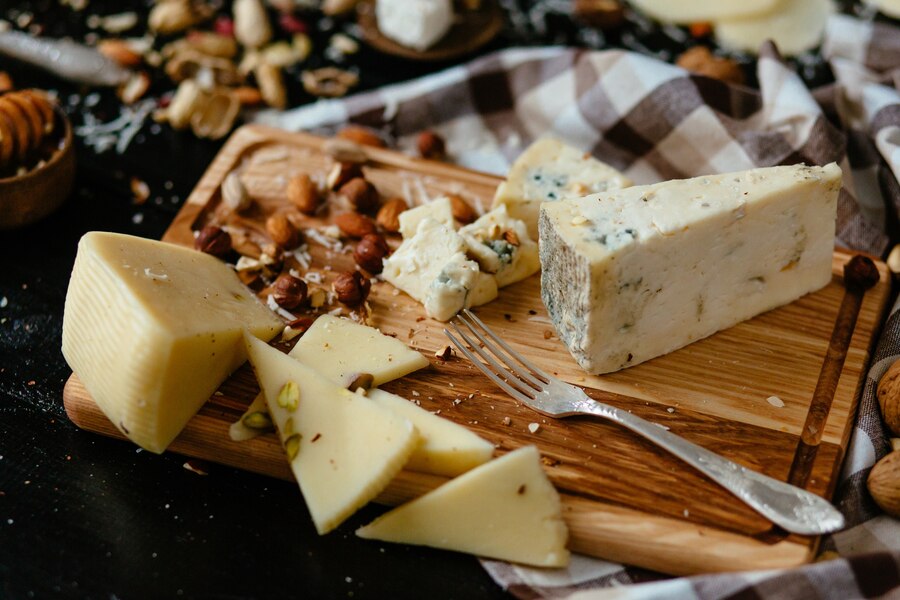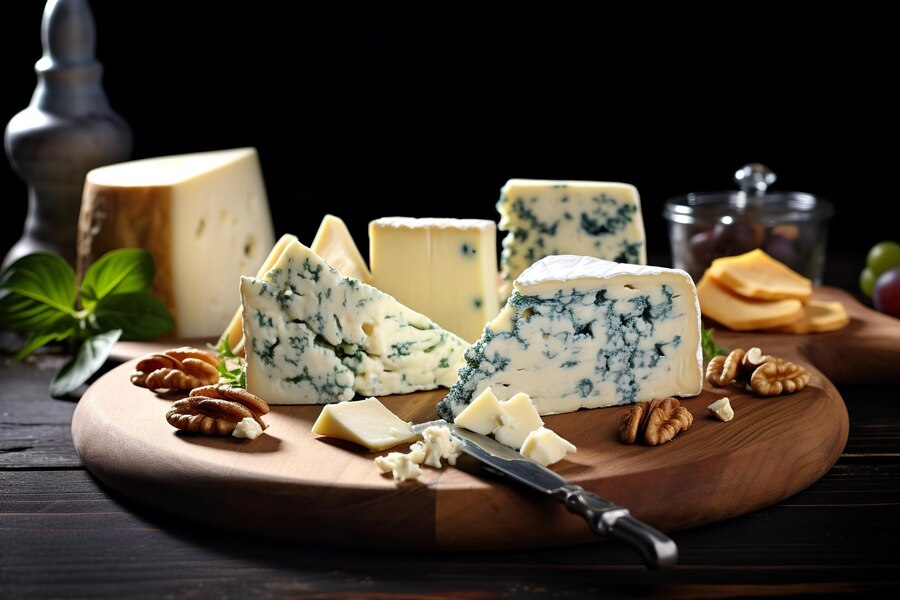When you think of blue cheese, Gorgonzola often stands out with its distinct veining and rich flavors. But what exactly sets this Italian marvel apart? Let’s dive into the world of Gorgonzola, uncovering its history, varieties, and how you can savor every bite of this delicious cheese.
History of Gorgonzola
Legend has it that Gorgonzola cheese was first made in the town of Gorgonzola, near Milan, in the 9th century. Though the exact details are a bit murky, the cheese’s unique character has been delighting palates for over a thousand years.
Evolution Through the Centuries
Gorgonzola evolved from a local specialty to an internationally celebrated cheese. Through improved cheese-making techniques and aging processes, its flavors became more refined and consistent, leading to the two main types we enjoy today: Gorgonzola Dolce and Gorgonzola Piccante.
Gorgonzola Dolce
Also known as “sweet” Gorgonzola, this variety is creamy, soft, and mildly tangy. It’s aged for a shorter period, which gives it a milder, more buttery flavor, perfect for spreading on bread or crackers.
Gorgonzola Piccante
For those who prefer a bit more kick, Gorgonzola Piccante, or “spicy” Gorgonzola, is the way to go. Aged longer, it develops a firmer texture and a more robust, tangy taste that adds depth to dishes.
Milk Selection and Treatment
Quality Gorgonzola starts with top-notch cow’s milk. The milk is usually pasteurized to ensure safety and consistency.
The Art of Curdling
Curdling agents are added to the milk, which is then left to form curds. These curds are cut and drained, starting the transformation from milk to cheese.
Aging and Ripening
The curds are salted and placed in molds. Here’s where the magic happens: penicillium roqueforti mold is introduced, creating those characteristic blue veins. The cheese is aged in cool, humid environments to develop its signature flavor and texture.
Gorgonzola Dolce Characteristics
Gorgonzola Dolce is known for its sweet, creamy taste. Its blue veins are less pronounced, providing a milder flavor that appeals to a wide range of palates.
Gorgonzola Piccante Characteristics
In contrast, Gorgonzola Piccante offers a stronger, spicier taste. Its crumbly texture and intense flavor make it a favorite for those who enjoy bold cheeses.
Comparing to Other Blue Cheeses
Compared to other blue cheeses like Roquefort or Stilton, Gorgonzola strikes a balance between creaminess and tanginess. Its versatility in both mild and strong varieties makes it a unique addition to the blue cheese family.
Caloric Content
Gorgonzola, like most cheeses, is calorie-dense. A 1-ounce serving typically contains around 100-120 calories.
Vitamins and Minerals
Rich in calcium, vitamin A, and proteins, Gorgonzola provides several essential nutrients that support bone health and overall well-being.
Health Benefits
Moderate consumption of Gorgonzola can offer health benefits such as improved gut health due to its probiotic content, along with the benefits of its rich nutrient profile.
In Salads and Dressings
Crumble Gorgonzola Dolce over salads for a creamy touch or blend it into dressings for a tangy kick.
As a Pizza Topping
Replace or complement your usual mozzarella with Gorgonzola Piccante for a gourmet twist on pizza.
In Sauces and Dips
Melt Gorgonzola into sauces for pasta or create decadent dips that pair perfectly with vegetables or bread.
Pairing with Fruits and Nuts
Combine Gorgonzola with fruits like pears or apples and nuts such as walnuts for a sophisticated appetizer or snack.
Proper Storage Techniques
Wrap Gorgonzola in wax paper or aluminum foil, then place it in an airtight container. Store it in the refrigerator’s vegetable drawer where humidity levels are ideal.
How to Extend Shelf Life
To extend its shelf life, change the wrapping every few days to keep it fresh and prevent excess moisture buildup.
Gorgonzola Pasta
Cook pasta and toss it with a creamy Gorgonzola sauce made from melted cheese, cream, and a dash of pepper.
Gorgonzola-Stuffed Mushrooms
Stuff large mushrooms with a mixture of Gorgonzola, breadcrumbs, and herbs, then bake until golden.
Gorgonzola and Pear Salad
Mix fresh greens with sliced pears, toasted walnuts, and crumbled Gorgonzola, then drizzle with a balsamic vinaigrette.
Traditional Italian Dishes
Gorgonzola is a staple in many Italian dishes, from risottos to polenta. Its creamy texture and robust flavor enhance a variety of traditional recipes.
Regional Variations
In different regions of Italy, Gorgonzola may be used in unique ways, reflecting local tastes and culinary traditions.
What to Look for in Quality Gorgonzola
Look for a well-distributed blue veining and a consistent texture. The aroma should be fresh and pungent, indicative of its quality.
Best Places to Buy
Purchase Gorgonzola from reputable cheese shops, gourmet grocery stores, or online retailers specializing in high-quality cheeses.
Gorgonzola’s Global Influence
Gorgonzola has influenced cuisines worldwide, from the United States to Asia, where it’s used in both traditional and innovative dishes.
Adaptations in Different Cuisines
Chefs globally adapt Gorgonzola to local flavors, creating unique dishes that blend Italian tradition with regional ingredients.
Myths About Blue Cheese
One common myth is that blue cheese is unsafe to eat. In reality, the mold used in Gorgonzola is safe and beneficial.
Clarifying Misunderstandings

Another misconception is that all blue cheeses taste the same. Gorgonzola’s varieties offer a wide range of flavors, from mild to intense.
Conclusion
Gorgonzola stands out in the world of blue cheeses with its rich history, distinctive varieties, and versatile uses. Whether you’re a seasoned cheese lover or just starting your cheese journey, Gorgonzola offers something special for everyone. So next time you’re at the cheese counter, why not give Gorgonzola a try?
FAQs
How is Gorgonzola different from other blue cheeses?
Gorgonzola comes in two main varieties: Dolce (sweet and creamy) and Piccante (spicy and crumbly), offering a range of flavors from mild to robust.
Is Gorgonzola safe to eat during pregnancy?
It’s best to consult with a healthcare provider, but generally, pasteurized Gorgonzola is considered safe during pregnancy.
What’s the best way to soften Gorgonzola for spreading?
Let Gorgonzola sit at room temperature for about 30 minutes before spreading. This softens the texture and enhances the flavor.
Can Gorgonzola be frozen?
While Gorgonzola can be frozen, it may alter the texture. It’s best enjoyed fresh for optimal taste and consistency.
How long does Gorgonzola last once opened?
When properly stored, Gorgonzola can last up to 3-4 weeks in the refrigerator. Keep it wrapped and in an airtight container for best results.
